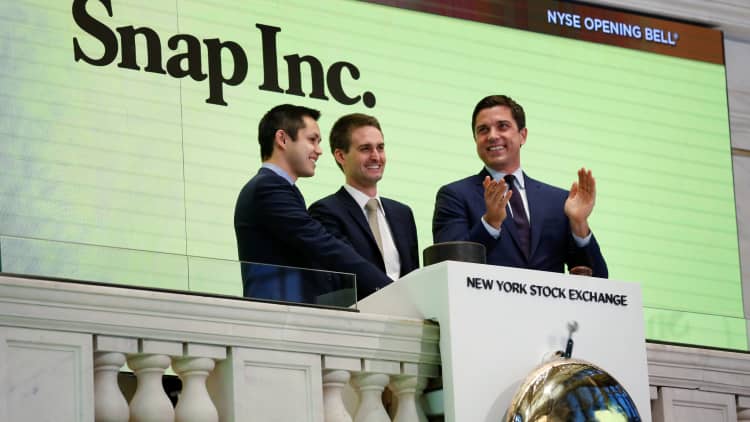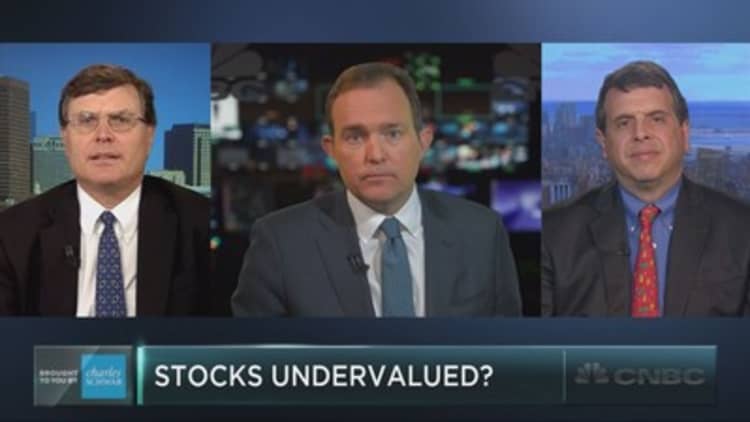


Snap's future, at least in the near term, may not be all doe eyes and rainbow filters.
Analysts are now more bearish on Snap than any other large U.S.-listed stock, with research analysts' current median price target at $15.50, according to FactSet. That's a loss of nearly 35 percent from its previous closing price of $23.77.
That potential downside is greater than that of any other large-cap U.S.-listed stock, when measuring the downside implied between their last closing prices and FactSet's median price targets.
Among the chief concerns for Wall Street are profitability, competition and the size of Snap's potential market.
In a Monday note, Needham entertainment and internet analyst Laura Martin gave Snap an underperform rating, saying the stock is like a "lottery ticket."
"Sometimes lottery tickets do pay off," Martin wrote. She added that an examination of its fundamentals indicates its total addressable market is smaller than that of Facebook's and its ideas may be stolen from competitors. There's "no clear path to profitability before 2020," she wrote.
Pivotal Research Group analyst Brian Wieser has the most bearish price target, at $10, explaining that Snap is overvalued and Snap investors will be exposed to "an upstart racing aggressive competition from much larger companies."
Snap as of Monday's market close had three sell ratings, two hold ratings, and two underweight ratings from Wall Street analysts.
After a big post-IPO pop, Snapchat's parent company saw shares fall below their opening price in Monday trading.
"History's sort of working against Snap a little bit in terms of the analyst community," Rich Ross, Evercore ISI's head of technical analysis, said Monday on CNBC's "Trading Nation."
"First of all, I think people want to sort of cover their assets, if you will, here with markets at all-time highs. There's a notion that perhaps Snap coming at the top — at those all-time [market] highs — could be the proverbial bell that rings, but I don't think that's the case at all, here," Ross said.
On top of that, perhaps Wall Street saliently remember being burned following Facebook's initial public offering in May 2012, Ross suggested. Shares fell over 40 percent in the four months following the company's highly anticipated public debut. Some market watchers have compared Snap's debut to Twitter, which went public in November 2013 and has since tumbled over 60 percent.
One obvious issue that sticks out to Eddy Elfenbein, editor of the Crossing Wall Street blog, is that Snap is losing money.
Indeed, the company warned in a filing with the Securities and Exchange Commission in February that it may never achieve profitability.
"We have incurred operating losses in the past, expect to incur operating losses in the future, and may never achieve or maintain profitability," Snap wrote in its S-1 filing, adding that "the loss of one or more of our key personnel, or our failure to attract and retain other highly qualified personnel in the future, could seriously harm our business."
"They're losing tons and tons of money. Let's be frank: They had a great IPO. And they're a lot better at raising money than they are at making money," Elfenbein said Monday on CNBC's "Trading Nation."
Snap may have chosen to go public at a time when the market is doing particularly well, Elfenbein said; the tech sector is the best-performing sector in the S&P 500 year to date, outperforming the market by about 4 percent.
Taking the other side, Ross believes the sector's leadership may ultimately be enough to carry Snap higher in the short- to intermediate-term.
Still, he acknowledged that "it's a stock that has to find itself."





